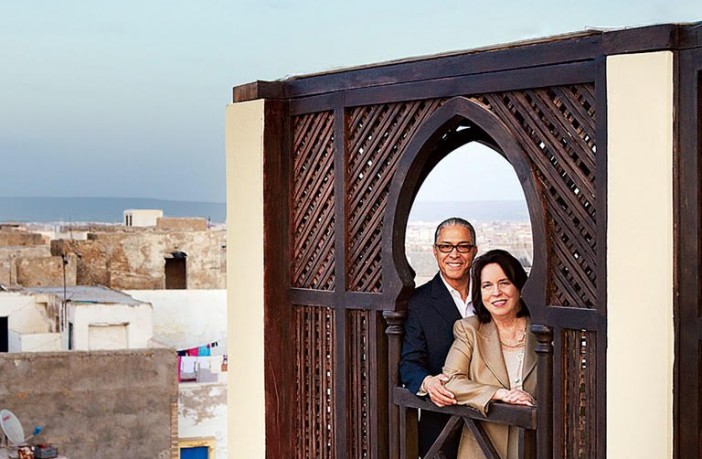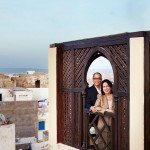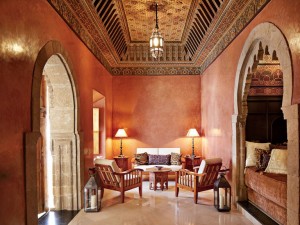Architectural Digest
Art dealer Dorothea Elkon takes a centuries-old house in Essaouira from ruin to rapture
This article originally appeared in the May 2012 issue of Architectural Digest.
People who holiday in Morocco typically buy a bold Berber carpet or the colorful leather slippers known as babouches. When art dealer Dorothea McKenna Elkon first traveled to the storied port of Essaouira, almost a dozen years ago, the New Yorker acquired a much more impressive souvenir: a crumbling 18th-century riad, or courtyard house, impulsively purchased several days after she landed.
“It was a coup de foudre,” says the owner and president of the Elkon Gallery, an Upper East Side fixture established in 1961 by her first husband, the late Robert Elkon. “I was astounded by the old stone arches surrounding the courtyard, but the rest of the place was in total disrepair.” Overlooking a slender alley in the densely packed medina, or walled heart, of this city of around 70,000, the three-level masonry structure was so decrepit that the upper floors would have to be demolished and rebuilt. Elkon was undaunted, having been bewitched by Essaouira’s wave-splashed ramparts and its languorous pace.
“A friend had told me Essaouira was one of the most beautiful places in Morocco,” she recalls. “A fishing town with white houses and blue doors.” What she discovered upon arrival was a spot largely unchanged since its founding in the 1760s. The city center, a UNESCO World Heritage site, has remained blissfully free of the package-tour hubbub that plagues other popular destinations in Morocco. And yet Essaouira was an easy flight from Paris, where the dealer keeps an apartment.
It was back in the French capital that Elkon’s ambitions for her new getaway came into focus. At a dinner party not long after her North African vacation, she met a dashing designer named Salem Grassi; the two got to talking, and she learned he was heading to Morocco the following week. “So I suggested he go to Essaouira to see my riad,” she says. Off he went, returning full of ideas. She quickly hired him to oversee the renovation; within two years the job was complete, and Grassi had plighted his troth. These days the couple, now married, spends nearly two months a year in the house that brought them together.
View Slideshow
Their approach to the project was simple. Grassi would be the man on the ground, while Elkon would visit as often as she could. In preparation for taking the riad from shambles to chic, the designer toured mosques and palaces in Morocco and Spain and, through contacts made on those journeys, tracked down accomplished painters, tile setters, and wood- and stone-carvers. The structure they had to work with conformed to the riad ideal: narrow, high-ceilinged rooms arranged around a central courtyard and accessed by galleries. Even with all that expertise at the ready, however, challenges abounded. “Moroccan artisans are great when it comes to techniques,” explains Grassi, who was born in Algeria and raised in Italy and France. “But none of them can read blueprints, so you draw a design on a wall and go from there.”
Since the only outstanding features were the ones Elkon first fell in love with—the ground floor’s stout columns and horseshoe arches—the renovation gave the couple an opportunity to dress the otherwise understated house in grander garb. Books about Islamic decorative traditions came in handy, notably Arabesques,Jean-Marc Castéra’s magisterial 1996 study of the geometric patterns found throughout the Arab world. Polychrome tilework called zellige appears on the riad’s new wall fountains and wainscots, while wood balustrades reminiscent of mashrabiyascreens outline the galleries like yards of golden lace. Most astonishing are the coffered wood ceilings, which were constructed on-site, often painted with abstract floral designs, and hoisted into position.
The pair collaborated on furnishing the house. With the eye of the fashion editor she once was—she worked at Vogue under Diana Vreeland—Elkon juxtaposed tailored contemporary objects, some designed by Grassi, with lush antiques such as a Spanish Baroque mirror picked up in Madrid. Because England, France, and Spain had major presences in Morocco for centuries, she notes, “Salem and I thought a mixture of pieces from those countries would be appropriate.”
Today the riad, dubbed Dar Maktoub (House of Destiny), is pasha-perfect—a five-bedroom, six-bath urban mansion. Breakfasts and lunches are taken in a fanciful mahogany pavilion on the roof, with views of island-studded Mogador Bay and the Atlantic. Dinners are often held in the courtyard, now paved with Portuguese marble and protected from rain and windblown sand by a glass skylight. After meals, house guests can retire to the ground-floor salon or to their bedrooms above; a tiled hammam, or steam room, is located off the third-floor master suite.
To some, the house’s splendor is startling, given the extreme modesty of its façade. Yet both are hallmarks of Moroccan style. Even when riads are palatial, “they don’t provide a lot of information from the outside,” Grassi explains. “The front door is usually very insignificant—but then you push it open to find so much beauty.”









